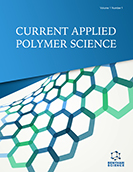Abstract
Background: Quinoxaline is an important nucleus used in the development of novel potentially bioactive structures. Hence, the development of new methodologies that provide access to this scaffold in shorter times and increased yields is of interest. In this work, we review many interesting microwave-assisted methodologies for the synthesis of quinoxalines reported from 2007 to 2015.
Methods: The most prominent methods for the synthesis of quinoxalines under microwave irradiation published in articles from 2007-2015 are reviewed.
Conclusion: Microwave irradiation proved to be a useful tool, providing many advantages on the synthesis of this class, such as shorter reaction times, higher yields and better selectivity, when compared to classical procedures.
Keywords: Catalysis, drugs, green chemistry, microwave, quinoxaline, synthesis.
Graphical Abstract
Current Microwave Chemistry
Title:Microwave-Assisted Synthesis of Quinoxalines - A Review
Volume: 4 Issue: 4
Author(s): Cristiane Franca da Costa, Marcus Vinicius Nora de Souza*, Claudia Regina Brandao Gomes and Victor Facchinetti
Affiliation:
- Departamento de Sintese de Farmacos, Farmanguinhos, Fundacao Oswaldo Cruz, Rio de Janeiro,Brazil
Keywords: Catalysis, drugs, green chemistry, microwave, quinoxaline, synthesis.
Abstract: Background: Quinoxaline is an important nucleus used in the development of novel potentially bioactive structures. Hence, the development of new methodologies that provide access to this scaffold in shorter times and increased yields is of interest. In this work, we review many interesting microwave-assisted methodologies for the synthesis of quinoxalines reported from 2007 to 2015.
Methods: The most prominent methods for the synthesis of quinoxalines under microwave irradiation published in articles from 2007-2015 are reviewed.
Conclusion: Microwave irradiation proved to be a useful tool, providing many advantages on the synthesis of this class, such as shorter reaction times, higher yields and better selectivity, when compared to classical procedures.
Export Options
About this article
Cite this article as:
da Costa Franca Cristiane , Nora de Souza Vinicius Marcus *, Brandao Gomes Regina Claudia and Facchinetti Victor , Microwave-Assisted Synthesis of Quinoxalines - A Review, Current Microwave Chemistry 2017; 4 (4) . https://dx.doi.org/10.2174/2213335604666171010153416
| DOI https://dx.doi.org/10.2174/2213335604666171010153416 |
Print ISSN 2213-3356 |
| Publisher Name Bentham Science Publisher |
Online ISSN 2213-3364 |
 48
48 2
2 1
1 1
1
- Author Guidelines
- Bentham Author Support Services (BASS)
- Graphical Abstracts
- Fabricating and Stating False Information
- Research Misconduct
- Post Publication Discussions and Corrections
- Publishing Ethics and Rectitude
- Increase Visibility of Your Article
- Archiving Policies
- Peer Review Workflow
- Order Your Article Before Print
- Promote Your Article
- Manuscript Transfer Facility
- Editorial Policies
- Allegations from Whistleblowers
- Announcements
Related Articles
-
Discussion on the Structural Modification and Anti-tumor Activity of
Flavonoids
Current Topics in Medicinal Chemistry Prostratin: An Overview
Mini-Reviews in Medicinal Chemistry New Targets for the Modulation of Radiation Response - Selective Inhibition of the Enzyme Cyclooxygenase 2
Current Medicinal Chemistry - Anti-Cancer Agents Advancements in Non-steroidal Antiandrogens as Potential Therapeutic Agents for the Treatment of Prostate Cancer
Mini-Reviews in Medicinal Chemistry A Review of Pharmacological and Phytochemical Studies on Convolvulaceae Species <i>Rivea</i> and <i>Ipomea</i>
Current Traditional Medicine Role of Genomic Alterations in HER2 Positive Breast Carcinoma: Focus on Susceptibility and Trastuzumab-therapy
Current Cancer Drug Targets Lentiviral Vectors for Gene Therapy of HIV-1 Infection
Current Gene Therapy Important Anti-Cancer Applications of Protein Based Nanoparticles
Current Proteomics Topical Imiquimod: Mechanism of Action and Clinical Applications
Mini-Reviews in Medicinal Chemistry Mechanisms of Apoptosis Induced by Anticancer Compounds in Melanoma Cells
Current Topics in Medicinal Chemistry Quinone Methides as DNA Alkylating Agents: An Overview on Efficient Activation Protocols for Enhanced Target Selectivity
Current Organic Chemistry Oligonucleotides as Anticancer Agents: From the Benchside to the Clinic and Beyond
Current Pharmaceutical Design Study of HIV Resistance Mutations Against Antiretrovirals using Bioinformatics Tools
Current HIV Research Heat Shock Proteins in Cancer: Signaling Pathways, Tumor Markers and Molecular Targets in Liver Malignancy
Protein & Peptide Letters Gene Therapy in In Vivo Isolated Perfusion Models
Current Gene Therapy An Overall Picture of Chemokine Receptors: Basic Research and Drug Development
Current Pharmaceutical Design Potential Impact of Genetic Variants in Nrf2 Regulated Antioxidant Genes and Risk Prediction of Diabetes and Associated Cardiac Complications
Current Medicinal Chemistry Competition Between Tumor and Mononuclear Phagocyte System Causing the Low Tumor Distribution of Nanoparticles and Strategies to Improve Tumor Accumulation
Current Drug Delivery Immunossupressant and Organ Transplantation: Immunophilins Targeting Agent and Alternative Therapies
Current Medicinal Chemistry The Role of Pericytes in Blood-Brain Barrier Function and Stroke
Current Pharmaceutical Design

























